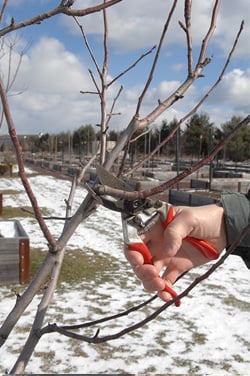GARDEN BLOG
Winter Pruning
Winter is one of the best times of year to prune your deciduous shrubs and trees, including fruit trees.
With deciduous trees and shrubs you are able to see the shape of the tree with their leaves fallen. You can then target certain areas which may need attention. Evergreens typically should be pruned in spring to avoid the possibility of tip-burn.

The first rule of thumb with pruning is to remove any dead and diseased wood. Next, remove any crossing or rubbing branches. Also, look for any suckers at the base of the trunk or shrub and remove them. Suckers are usually thin, straight branches that form at the base of the plant.
Most importantly, never leave a stub when pruning. Always make your pruning cut just above a bud or cut back to an existing branch. If a woody stub is left, it can easily become infected by disease. If cutback to a bud, you will have new growth from that bud in the coming spring.
An overall thinning of a tree can be very beneficial. This involves pruning smaller branches throughout the tree, working through the whole interior of the tree canopy to the outer exterior portions of it. This thinning will allow more light and air circulation into the tree canopy. Just make sure you never remove more than a third of the wood from the tree in a year.
It is also advisable to use clean, disinfected pruning shears to avoid spreading disease. Pruning shears can be cleaned with a 10% solution of rubbing alcohol to water.
So the next warm, dry winter day on the horizon, get outside and get a head start on your pruning.
